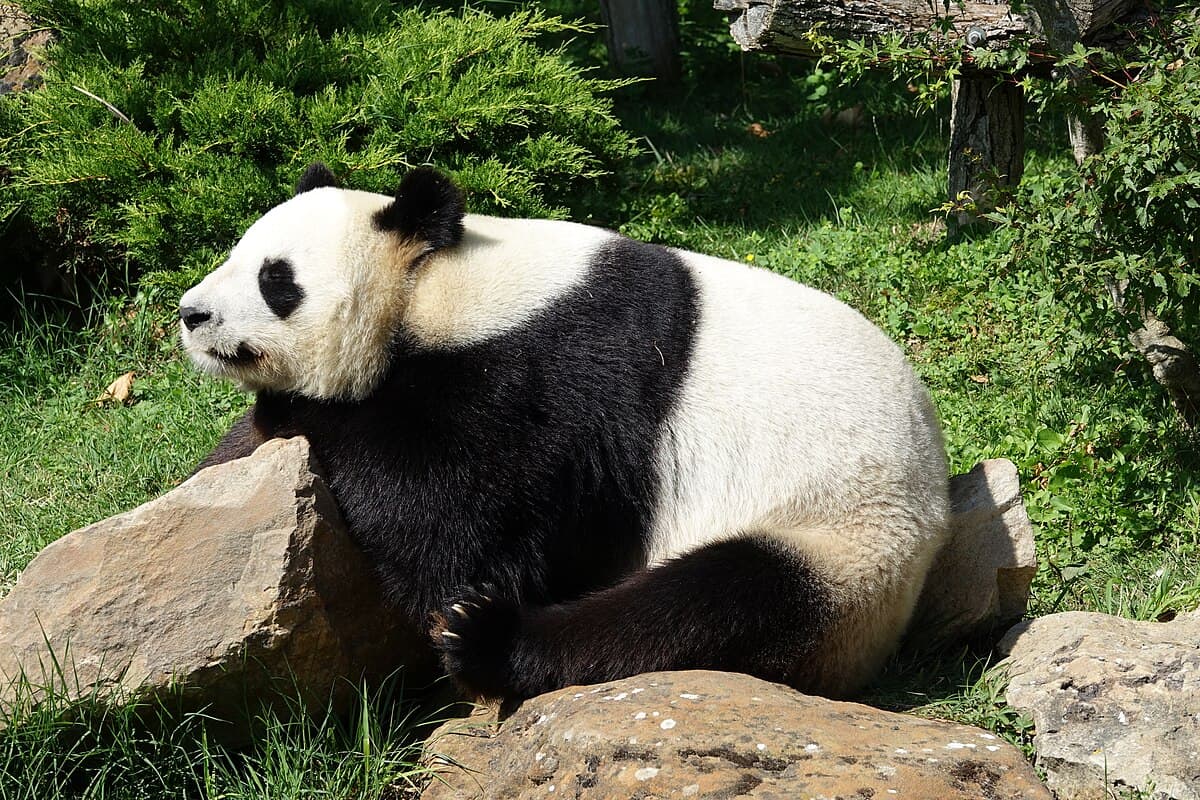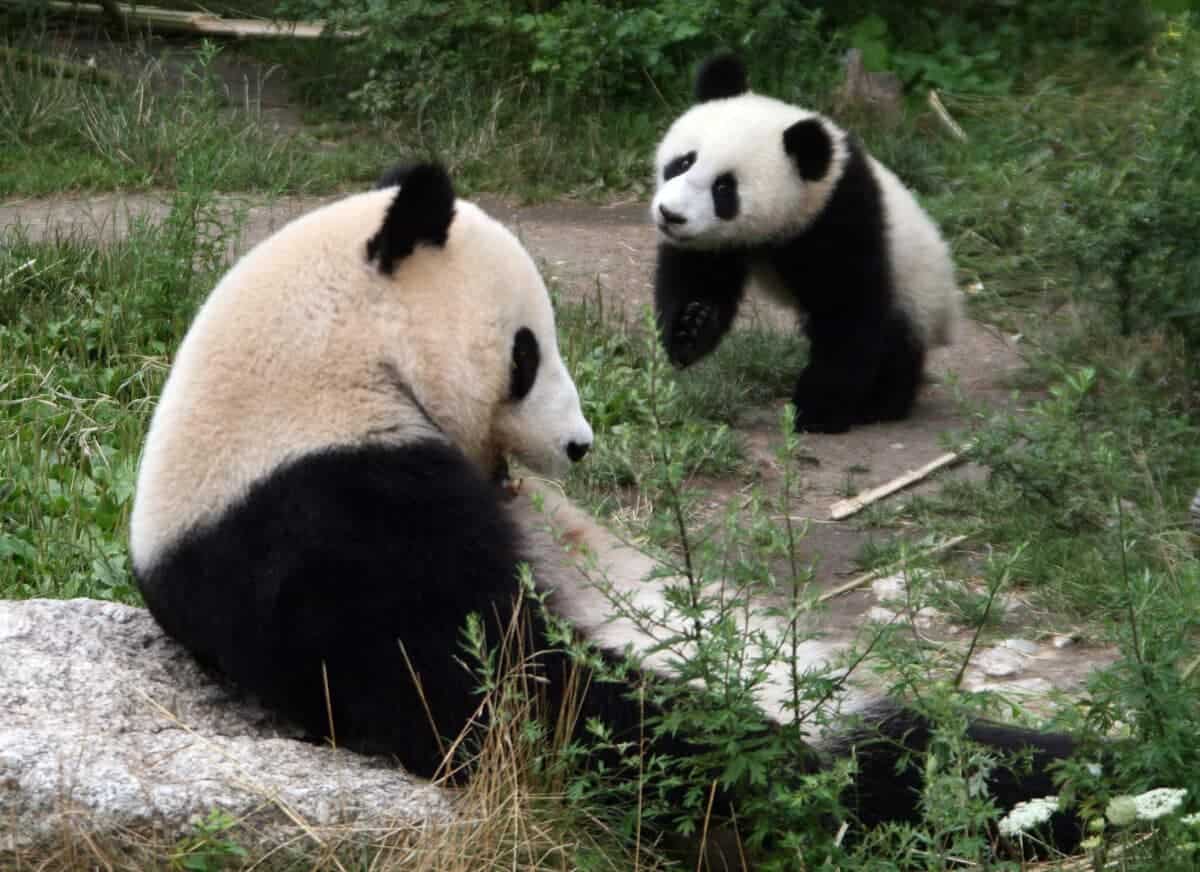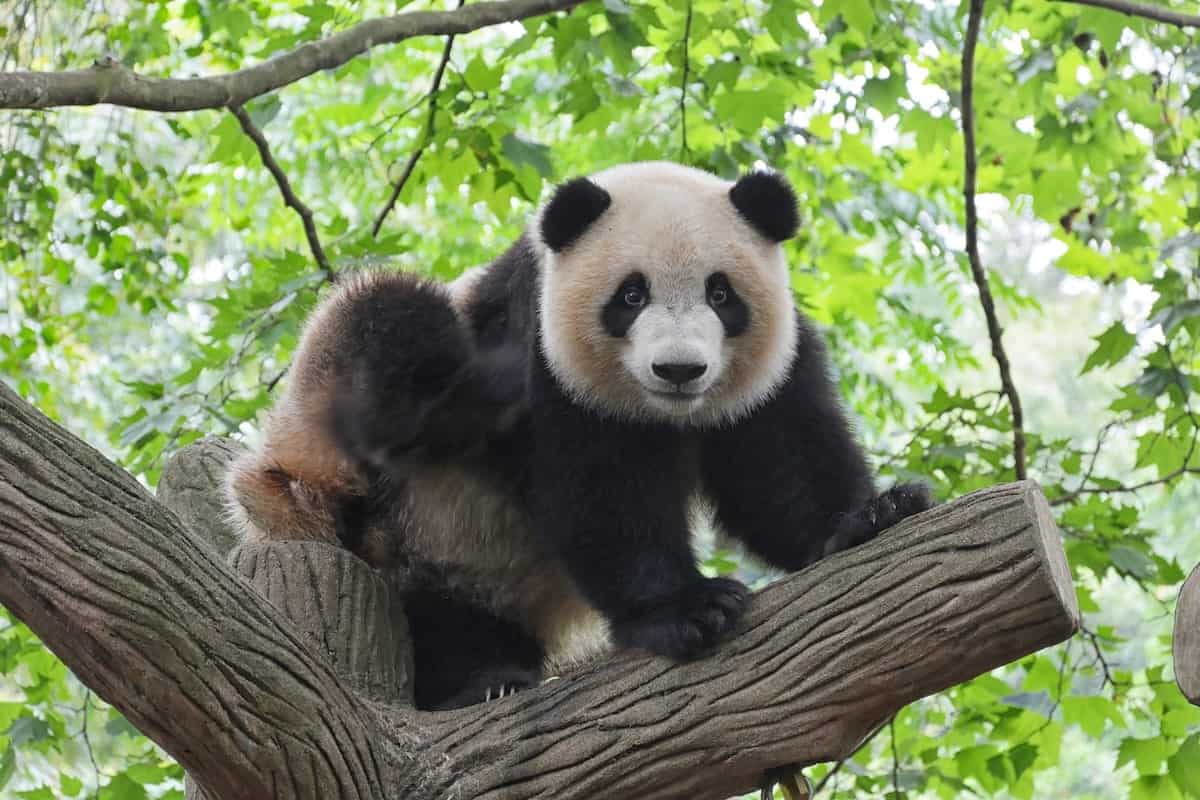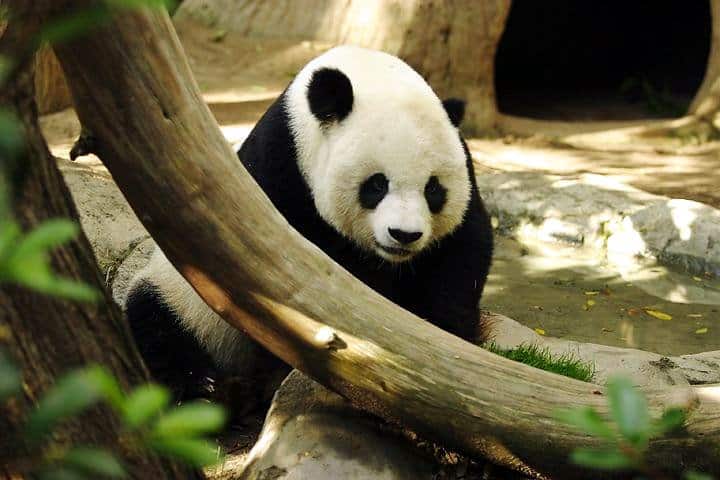Looking for the Best Places to See Giant Pandas?
Giant Pandas are adored worldwide, mainly for their black, white, and fluffy appearance and somewhat clumsy nature. These soft bears, native to China, are unfortunately endangered and have made it onto our list of the world’s most endangered bears.
This is mainly attributable to significant habitat destruction and loss experienced in the past few decades. This blog will give you a glimpse into the life of these adorable bears.

Key points
| Topic | Key Points |
|---|---|
| Appearance and Characteristics | – Giant Pandas have distinctive black and white markings. |
| – They have black patches around eyes, ears, legs, and a band on their back. | |
| – Their fur is coarse, dense, and helps them stay warm in cool climates. | |
| – They move slowly and appear clumsy. | |
| Food and Diet | – Though classified as carnivores, pandas mainly eat bamboo. |
| – They consume around 25-40 pounds of bamboo daily. | |
| – Occasionally, they eat other foods like fish, flowers, and small animals. | |
| Sense of Smell | – Pandas use scent marks for communication and territory marking. |
| – Scent helps determine gender, reproductive status, and recent activity. | |
| Vocalizations | – Pandas have diverse vocalizations for different situations. |
| – Cubs have limited initial vocalizations, develop more as they grow. | |
| Reproduction | – Breeding maturity at 4-8 years, low reproductive rate due to limited ovulation. |
| – Habitat fragmentation hampers breeding. | |
| – Females give birth to 1-2 cubs, triplets are rare. | |
| Habitat | – Once widespread, pandas now limited to specific Chinese provinces. |
| – Threatened by habitat loss, fragmentation, and reduction in bamboo forests. | |
| Current Status | – About 1,864 wild pandas estimated in 2014, with 600 in captivity. |
| – Protected under U.S. ESA and CITES, conservation efforts ongoing. | |
| Best Places to See Giant Pandas | – Seeing wild pandas is rare; options include Natural Habitat Adventures, China Discovery, Wild China. |
Appearance and Characteristics

| Statistic | Information |
|---|---|
| Scientific Name | Ailuropoda melanoleuca |
| Conservation Status | Vulnerable |
| Habitat | Temperate forests of China |
| Diet | Primarily bamboo |
| Average Lifespan | 20-30 years |
| Adult Weight | 70-125 kg (154-276 lbs) |
| Body Length | 1.2-1.5 m (4-5 ft) |
| Tail Length | 10-15 cm (4-6 in) |
| Gestation Period | About 5 months |
| Cubs per Birth | Usually 1 or 2 |
| Activity | Mainly crepuscular (active during dawn and dusk) |
| Predators | Few natural Predators, mainly humans due to habitat loss and poaching |
Giant Pandas are instantly recognizable by their distinctive black and white fur, featuring black patches around their eyes, ears, and legs, contrasted with white heads and midsections, and a black band across their backs.
Despite their similar markings, caretakers at conservation facilities can identify individual pandas through small unique markings around their mouths or muzzle. Their coarse, dense, and slightly oily fur serves as insulation in the cool, damp mountain forests they inhabit.
Unlike most bears, Giant Pandas are generally slow-moving and appear somewhat clumsy in their movements, usually not moving faster than a walk.
Food and diet
Giant Pandas are formally categorized as carnivores, yet their diet aligns more closely with herbivores. While carnivores mainly consume meat and herbivores primarily eat plants. Giant Pandas predominantly eat bamboo stalks, shoots, and roots, consuming about 25 to 40 pounds per day from a selection of approximately 25 bamboo species.
Occasionally, Giant Pandas supplement their diet with fish, flowers, and small animals, although this occurs infrequently. In captivity, they receive a varied diet including milk, eggs, ground meat, vitamin bread, apples, and carrots. Due to their inefficient digestive system, Giant Pandas must consume large quantities of bamboo daily for adequate nutrition, particularly vulnerable are the cubs in their early months of life.
These bears spend up to 14 hours daily feeding. Their distinctive paws facilitate holding and biting bamboo stalks. Despite their carnivorous classification, their powerful cheek muscles enable them to chew the tough bamboo effectively. Unlike most bears, Giant Pandas do not hibernate, constantly seeking food due to their inability to store fat.
A challenge faced by wild Giant Pandas is the periodic flowering and dying of bamboo species, taking years for recovery. Historically, pandas migrated for new bamboo, but fragmented habitats now limit this, contributing to their unfortunate and continual population decline.
Giant Pandas in the wild drink water from the rivers and streams in their surrounding mountain environment.
Sense of smell:

Giant Pandas leave scent marks in their territories as their scent marks serve as a significant form of communication.
Giant Pandas can determine from the scent if another Giant Panda is in the area if the other Giant Panda is male or female, how recently they left their mark, and, in the case of females, if they are in a reproductive period.
To mark their location, Giant Pandas will back up to a tree, rub their scent glands on it, and then use their tail to spread the scent. Some Giant Pandas, particularly males, will back up on the tree until they do a handstand to place their scent higher on the trunk.
Vocalizations:

Since 2010, the China Conservation and Research Center for the Giant Panda has studied panda vocalizations. Recordings captured various interactions between cubs and adults during activities like eating, mating, nursing, and conflicts.
In 2015, researchers decoded about 13 distinct panda vocalizations, revealing insights into their private lives. Cubs’ vocalizations are basic, indicating hunger or discomfort. As they grow, pandas communicate through sounds like roaring, barking, and chirping, each conveying specific messages.
Researchers observed behaviors like territorial defense, courtship, and affectionate responses, initially finding the variety of sounds confusing but illuminating in understanding panda behavior.
Reproduction:

Giant Pandas reach breeding maturity between four to eight years and produce offspring once a year in spring. Their low reproductive rate results from females ovulating only a few days annually.
In the wild, pandas use scents and calls to find mates during the breeding season, but habitat fragmentation hampers mating as male pandas struggle to reach females due to human-made barriers. Pandas nest on the ground or in scarce hollow trees, giving birth after about 100 to 150 days.
Cubs are usually born singularly, with twins being rare and usually resulting in only one surviving in the wild due to the mother’s limited ability to provide enough milk. Cubs stay with their mothers for about two years, leading to females reproducing every other year or less.
Breeding Giant Pandas in zoos has seen limited success, but breeding centers in China have improved success rates by employing natural mating and artificial insemination techniques in recent years.
Habitat:

The Giant Panda was once widespread in southern and eastern China, Vietnam, and Myanmar (Burma). Presently, they mainly inhabit mountains in a few southwestern Chinese provinces: Sichuan, Shaanxi, and Gansu, along the eastern edge of the Tibetan Plateau.
These pandas don’t have permanent dens, don’t hibernate, and seek shelter in hollow trees during winter. They cover a territory of 4-7 kilometers and can travel up to 10 kilometers daily in search of food, water, and shelter.
For centuries, Giant Pandas have lived in coniferous forests with dense bamboo undergrowth at elevations of 5,000 to 11,000 feet. These forests experience continuous rainfall or mist, often shrouded in clouds year-round, with snowy winters.
Presently, these forests face escalating threats due to a surge in human population. Activities such as agriculture, ranching, logging, trapping, and human settlements pose significant risks to their habitat. These animals once inhabited lower elevations, but the expansion of farming and forest clearing has forced them to migrate higher into the mountains.
The Giant Panda’s primary food source, bamboo, is decreasing. Bamboo grows under the shade cover of the giant fir trees. Logging and clearing the land for agricultural uses is a significant factor in reducing bamboo.
The impact of rapid population growth has seen the destruction of significant Giant Panda habitat. To defend the Giant Panda, the Chinese Government enforces a logging ban in the Giant Panda reserves.
The 8.0 earthquake of 2008 was in Sichuan Province, home to the Giant Pandas. The quake buried much of the Giant Pandas’ bamboo under tons and tons of rock and mud.
In the 1940s, the Chinese Government began conservation efforts to protect pandas. In 1963 the first panda reserve was established in southern China. Pandas were classified as an endangered species in the 1980s.
Today there are 40 Giant Panda reserves in China. These reserves need to be connected via corridors to reduce the isolation and fragmentation of the Giant Panda population. Villages and human activities now block open ranges for migration, and the fragmentation of Giant Panda areas is a significant problem affecting mating.
Another problem related to the fragmentation of the Giant Panda areas is that the bamboo will flower and then die off about every 20 years. When this occurs, the Giant Pandas need to migrate to a new location. There have been reports of Giant Pandas starving when they cannot find bamboo in new places.
The destruction of the Giant Pandas’ natural habitat, the reduction in available bamboo forests, and expanding human populations are the main threats to the Giant Panda.
Current Status:
A study in 2014 by the Chinese Department of Forestry estimated the current population of the wild Giant Pandas at approximately 1,864. As of 2020, there are about 600 giant pandas in captivity, and giant pandas are on the World Conservation Union’s Red List of Threatened Animals.
The U.S. Endangered Species Act (ESA) protects giant pandas and the Convention on International Trade in Endangered Species (CITES). While hunting and poaching have been reduced due to strict laws by the Chinese Government, accidental capture of giant pandas in traps set for other animals still poses a severe problem.
The future of the giant panda is interwoven with the Chinese people. New advances in environmentally responsible farming, high-yield crops to reduce logging, and population control efforts will help the giant pandas. The Chinese Government also has several projects for reforesting hillsides, and protecting grasslands and nature reserves for the giant pandas.
There are also plans to pay farmers to turn cropland back into forests and to establish commercial tree farms to replace logging. Bamboo planting, in Sichuan Province, for the captive and wild pandas is an ongoing project.
Status Change – Some people have questioned the change in status of the giant pandas, by the IUCN, from Endangered to Vulnerable. Let us take this opportunity to say, on the one hand; this is cause for celebration, and it shows that with your support, progress is being made in panda conservation.
The Chinese have been working since the 1960s to save their national treasure,, which affirms the efforts are paying off. The captive population is currently stable, as the number in captivity exceeds the number outlined in the Species Survival Plan.
That said…..there are still significant concerns, and we have NOT reached even modest goals in panda conservation. The IUCN states that the vulnerable status is still at high risk of extinction in the wild.
What does it mean for Panda Conservation? Our greatest fear is public and our supporters will think the pandas are safe at present and become complacent, that is not the case. The pandas could rapidly slide backward if the Government or the public gets lax in conservation efforts.
This change may have many unintended consequences, including more human activity and trekking in their habitat. A recent International Conference on Panda Conservation published conclusions stating the giant panda is still endangered.
Summary of Best Places to See Giant Pandas
Seeing a giant panda in the wild is highly lucky and rare! Should you wish to encounter one of these unique bears in the wild or i rehabilitation facility, below are a few options for you.
If you enjoyed this article,, you might enjoy reading more about bears! Brown bears in the wild and our complete guide to all of our bears.
Also check out
Brown Bear Vs. Grizzly Bear.
Frequently asked Questions (FAQs)
The exact number of giant pandas can vary due to ongoing conservation efforts and population surveys. As of 2021, it was estimated that there were around 1,800 wild giant pandas in China. In captivity, there were over 300 giant pandas, primarily located in specialized breeding centers and zoos.
They are native to China and are found in the mountainous regions of Sichuan, Shaanxi, and Gansu provinces. They inhabit temperate forests with dense bamboo undergrowth.
Habitat loss and fragmentation due to human activities, such as deforestation and urbanization, have been major threats to giant pandas. Additionally, the limited breeding rate of pandas, their specific dietary requirements, and the challenges in breeding in captivity have contributed to their vulnerability.
While giant pandas are generally known for their docile and calm demeanor, they can exhibit aggression if they feel threatened or provoked. Like any wild animal, pandas have the potential to defend themselves if they perceive danger
Pandas are wild animals and should be treated with caution and respect. While they might not generally show aggression toward humans, it’s important to remember that they are still bears and can react defensively if they feel threatened.
Join our Forum for free today!

- Third Elk Incident in Two Weeks in Estes Park, Colorado and How to Stay Safe - July 4, 2024
- 17 Animals That Mate For Life - June 24, 2024
- 13 Animals That Lay Eggs (Some Might Surprise You!) - June 16, 2024




